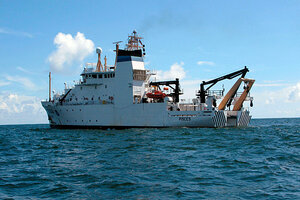Gulf oil spill: research voyage to search for oil can't find any
Halfway through a 10-day voyage, a government-sponsored expedition isn't finding any traces from the Gulf oil spill, directly contradicting findings by several independent research teams.

The NOAA research vessel called the Pisces prepares to test water from the Gulf of Mexico about nine miles south of BP's oil spill, on Aug. 21.
Ann Driver/Reuters
A government-sponsored expedition of scientists searching for leaked oil in the Gulf of Mexico is reporting Thursday that, more than halfway into the 10-day voyage, testing has not yet produced evidence of oil either in underwater plumes or embedded in sediment.
That conclusion contradicts recent findings by several independent research expeditions that discovered oil close to the Macondo well, which released 4.9 million barrels (205 million gallons) of oil into the Gulf following the April 20 explosion of the Deepwater Horizon oil rig. BP, which owned rights to the well, said it permanently plugged the Macondo well on Sept. 19. Some researchers say as much as 80 percent of the oil spilled since April remains in the Gulf.
The debate about how much oil remains in the Gulf started in August when a report published by the National Oceanic and Atmospheric Administration (NOAA), concluded that 74 percent of the oil had been recovered, evaporated or naturally dispersed, leaving a residual 26 percent “on or just below the surface” of water or in sand.
IN PICTURES: The Gulf oil spill's impact on nature
Following criticism from independent research efforts that complained it was too early to make such determinate results, NOAA pulled back from that report, suggesting that it was only intended as a work in progress that “will be updated as new data comes in,” says Ben Sherman, a NOAA spokesman.
NOAA voyage
Last week, NOAA launched a 209-foot research vessel called the Pisces to continue collecting data. The onboard team includes nine scientists from Texas A&M University and the University of California at Santa Barbara. The Pisces is one of several vessels NOAA is utilizing as part of its ongoing subsurface oil monitoring program that is conducting sampling in three areas: near the surface within three miles of the shore and within a 25-mile radius of the Macondo well, and deep below the water’s surface near the Macondo site.
In a teleconference with reporters Thursday, Janet Baran, a NOAA scientist and co-director of the monitoring program, said the agency has so far collected 30,000 water and sediment samples from approximately 10,000 locations. Ms. Baran said traces of oil have diminished since sampling began in the spring, and at this time all water and sediment collected "have no visible oil on them.”
NOAA’s efforts are clashing with research expeditions from academic and environmental groups.
Rainer Amon, an assistant professor of marine science at Texas A&M University, reported Thursday his sampling showed remnants of an oil and gas plume about 300 miles from the Macondo wellhead and about 3,000 feet underwater. His testing was conducted during a 10-day expedition sponsored by Greenpeace. the environmental advocacy organization.
Mr. Amon said his measurements suggest that about four million barrels of oil still remain unaccounted for in the Gulf.
Baran would not comment on the Greenpeace report. She affirmed that NOAA’s “extensive water sampling all summer” has proved the oil near the Macondo well has “seen a decrease in concentration over time.”
At odds with other reports
NOAA is also having to answer to contrary findings reported earlier this month by Samantha Joye, a University of Georgia marine biologist whose team reported finding thick layers of oil deeply embedded on the ocean floor as far as 70 miles from the Macondo well site. Ms. Joye told ABC News that every sample her team collected was contaminated by oil from the April spill.
“We’re finding it everywhere that we’ve looked. The oil is not gone … it’s in places where nobody has looked for it,” she said.
Baran said NOAA’s research fleet plans to either visit or revisit sites Joye’s team have documented finding oil.
“We have not visited all her sites yet. We have not found any oil in sediments but we will continue to look,” she said.
Joye was also a member of a team of scientists that issued a report in mid-August that reported that 80 percent of the oil remained in the Gulf in a highly toxic state and that, due to the high volume of dispersants used near the Macondo site, it is impossible to estimate how long it will take for the oil to fully degrade. Another report issued around the same time by the University of South Florida in Tampa reported that dispersants were responsible for pushing oil into a deepwater canyon located about 40 miles off the Florida coast.
Baran said NOAA may “still have a long ways to go” before finishing its sampling program. “We’re trying to get to the whole answer here about the region’s impact,” she said.
